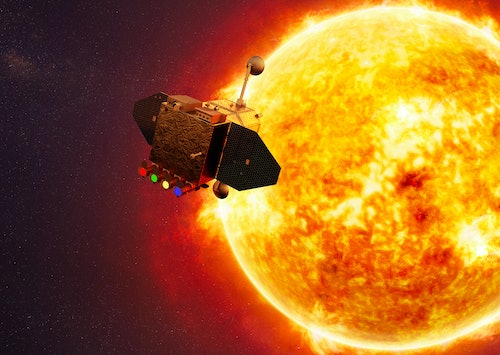Full of words like “cannibal cloud” and “x-class event,” solar flare news can sound alarming, but here’s the reality behind the hype. Despite the hype around today’s possible geomagnetic storms, there’s no reason to panic. Electrically-charged gas ejected from the surface of the Sun will collide with Earth’s magnetic field sometime today, sparking geomagnetic storms.
NOAA’s Space Weather Prediction Center . However, the weird solar phenomenon behind the storms, called a cannibal cloud, is terrifying and awesome. On July 15, the Sun belched a huge cloud of magnetized, electrically charged gas (called plasma) from its surface.
The belch, called a coronal mass ejection, came from a patch of the solar surface where magnetic field lines are twisting and unsettled: a sunspot called AR 3363. Since AR 3363 happened to be pointed toward Earth at the time, the cloud of plasma blasted through space toward our little blue planet, 94. 5 million miles away.
Illustration of solar flares on the surface of the Sun Along the way, the huge cloud of plasma overtook and swallowed another coronal mass ejection. The slower-moving plasma cloud had departed the Sun’s surface on July 14, erupted from a small, overlooked sunspot called AR 3370. The product of that merger, a so-called “ ” of plasma should reach Earth sometime today, July 18, in what NOAA describes as “a close proximity or glancing blow.
” Thanks to the cannibal cloud, we’re in for a minor geomagnetic storm. According to NOAA, there’s a 50 percent chance that the cannibal cloud will cause some minor disruption to radio signals here on Earth, ranging from weak signals to blackouts lasting a few minutes at a time, especially close to the Arctic and Antarctic; people in these high-latitude areas may also see some small fluctuations in their power grids. Some satellites in orbit may need to reorient to avoid damage.
There’s a smaller chance, around 20 percent, that the geomagnetic storm could cause radio blackouts lasting around an hour over wider areas. Either way, it’s not exactly the . What Does It All Mean? We’re approaching the Solar Maximum, when our Sun’s magnetic fields are most active.
Every 11 years, , and the activity before and after that flip can cause a flurry of solar flares, sunspots, and coronal mass ejections. That means that for the next couple of years, we’re all going to have to get used to . Just like there’s a system for ranking the severity of a hurricane, NOAA has a system for rating the strength of solar flares: class A is the weakest, followed by B, C, M, and X, with each class 10 times stonger than the last.
Both of the solar flares that blasted out huge chunks of the Sun’s upper layers over the weekend were class C flares, making them solidly middle-of-the-road events. NOAA says there’s “a slight chance” of class X flares over the next couple of days. Similarly, for the strength of geomagnetic storms, which happen when a coronal mass ejection hits Earth’s magnetic field; solar radiation storms, which happen when a burst of powerful solar radiation hits Earth; and radio blackouts.
For example, today’s geomagnetic storms are expected to be class G1 or G2. Radio blackouts have been rated at R2 in the last 24 hours, and they’re expected to be somewhere between R1 and R2 over the next couple of days, with a 20 percent chance of reaching R3. We’re also expecting an S1 solar radiation storm, thanks to a class M flare from sunspot AR 3363 (this one didn’t include a coronal mass ejection, apparently).
That’s mostly only a concern if you’re in orbit or in a high-flying plane near the poles. To put all that in context, Earth has already weathered several G4 and G5 geomagnetic storms already this year. If you didn’t notice those, you probably won’t notice this one, either.
But if you think cannibal clouds sound pretty cool, you’re in luck. They’re usually pretty rare, because they only happen when two coronal mass ejections blast into space along the same path, and when the second one is moving faster than the first. With our Sun moving into the most active part of its 11-year cycle, however, we can probably expect to see more cannibal clouds coming our way.
.
From: inverse
URL: https://www.inverse.com/science/x-class-solar-flares-coming-this-week-unlikely-says-noaa



